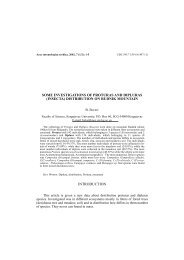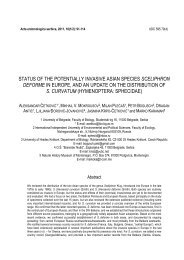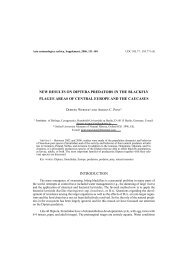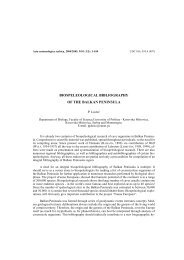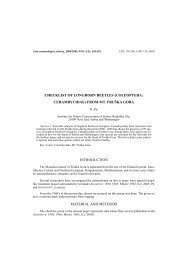Kollar, J. & Hrubik, P: The mining species
Kollar, J. & Hrubik, P: The mining species
Kollar, J. & Hrubik, P: The mining species
Create successful ePaper yourself
Turn your PDF publications into a flip-book with our unique Google optimized e-Paper software.
88<br />
J. KOLLÁR & P. HRUBIK<br />
Order Family Species/variety Host plant<br />
Diptera Agromyzidae Aulagromyza heringii (Hendel 1920) Fraxinus excelsior L.<br />
(Table I - continued)<br />
Aulagromyza cornigera (Griffiths, 1973) Lonicera xylosteum L., Symphoricarpos albus (L.)<br />
Blake<br />
Chromatomyia lonicerae (Robineau-Desvoidy, 1851) Lonicera xylosteum L.<br />
Liriomyza congesta (Becker, 1903) Colutea arborescens L.<br />
Aulagromyza populicola (Haliday, 1853) Populus nigra L.<br />
Recorded <strong>species</strong> feed on 40 genera and 18 families of host woody plants. <strong>The</strong> most <strong>mining</strong> <strong>species</strong> were<br />
recorded on the genera Quercus (18), Betula (14) and Populus (8) (Fig. 2a). Within woody plant families the<br />
highest number of <strong>mining</strong> insect <strong>species</strong> were recorded in the Betulaceae (24), Fagaceae (22), Rosaceae<br />
(17) and Salicaceae (13) families (Fig. 2b).<br />
a b<br />
Figure 1. Proportion of found insect <strong>species</strong> according to families (a) and orders (b) [families: 1 – Gracillariidae (32%), 2<br />
– Phyllocnistidae (3%), 3 – Coleophoridae (6%), 4 – Nepticulidae (21%), 5 – Tischeridae (3%), 6 – Yponomeutidae<br />
(3%), 7 – Tortricidae (3%), 8 – Curculionidae (3%), 9 – Tenthredinidae (5%), 10 – Agromyzidae (14%) and 11 – other<br />
(7%); orders: 1 – Lepidoptera (77%), 2 – Coleoptera (4%), 3 – Hymenoptera (5%) and 4 – Diptera (14%)].<br />
During the research we focused also on alien <strong>mining</strong> insect <strong>species</strong> and recorded in total 14 alien <strong>species</strong>.<br />
From this number the most abundant <strong>species</strong> come from the Mediterranean area [Phyllonorycter platani<br />
Staudinger, 1870; Acalyptris platani (Müller-Rutz, 1934); Agromyza demeijerei Hendel, 1920; Amauromyza<br />
elaeagni (Rohdendorf-Holmanová, 1959); Argyresthia trifasciata Staudinger, 1871; Cameraria ohridella<br />
(Deschka & Dimic, 1986)]. From North America four <strong>species</strong> [Phyllonorycter robiniellus Clemens, 1859;<br />
Parectopa robiniella Clemens, 1863; Coleotechnites piceaella (Kearfott, 1903) and Argyresthia thujella<br />
(Packard, 1871)] were brought to the Slovak area; from Asia three <strong>species</strong> [Phyllonorycter issikii Kumata,<br />
1963; Caloptilia roscipennella (Hübner, 1796) and Phyllonorycter leucographellus (Zeller, 1850)]; and the



